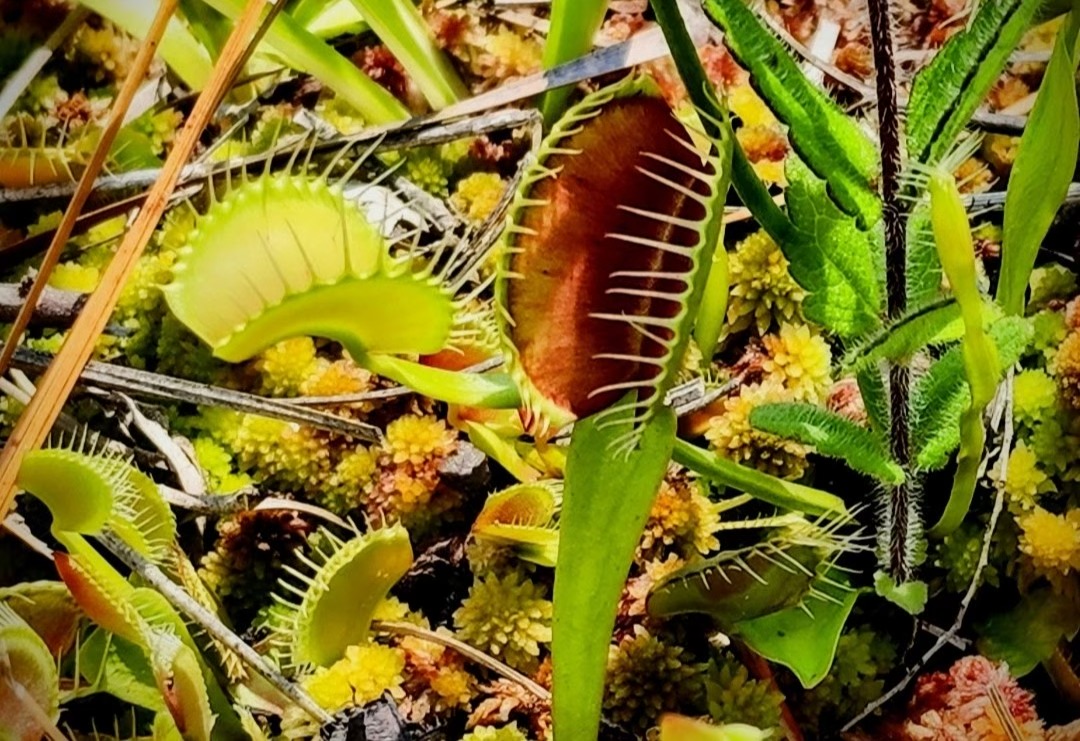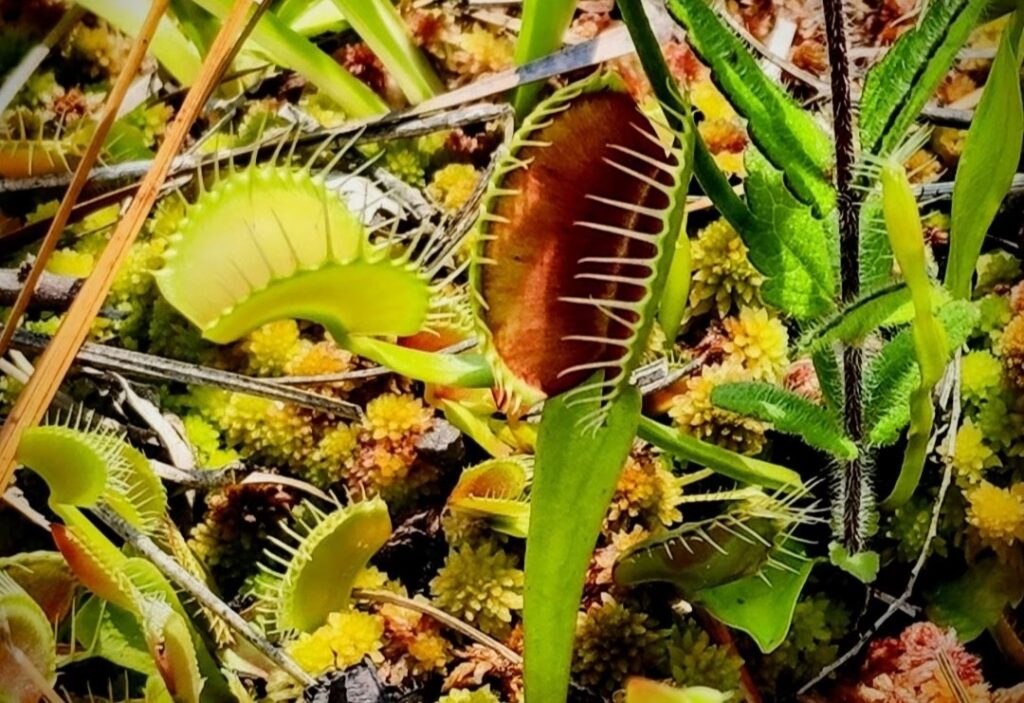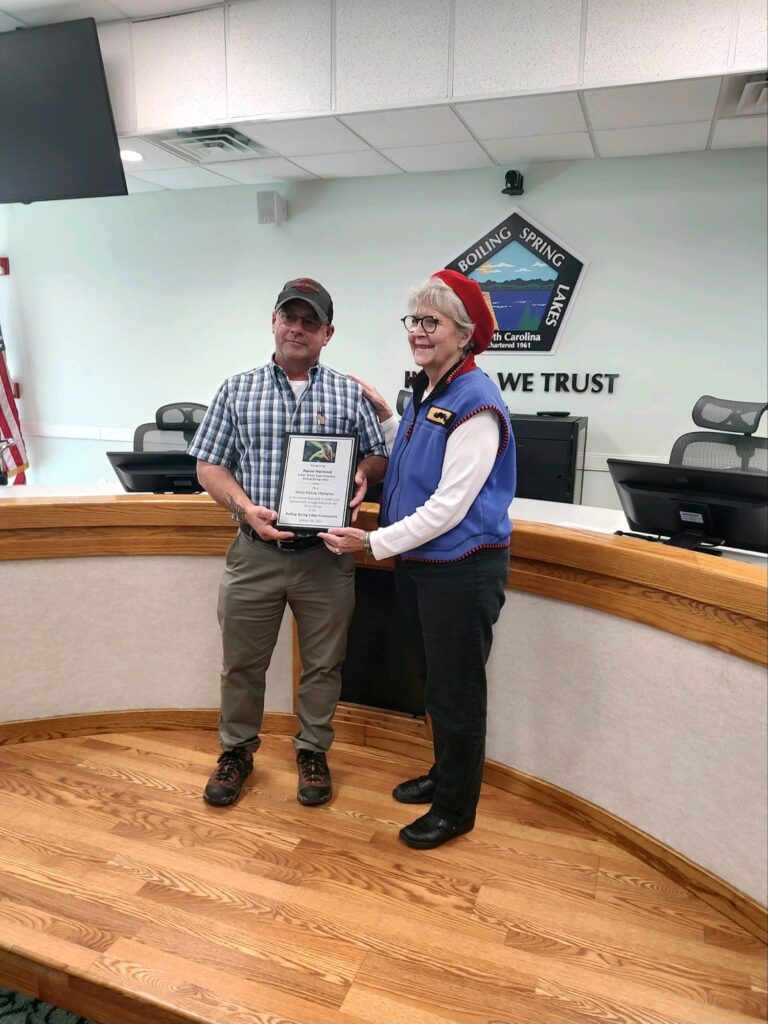VENUS FLY TRAPS THREATENED BUT THRIVING IN BOILING SPRING LAKES

Story by Patty Langer, Photos of Venus Fly Traps by Kathy Sykes
THE BIG DIG:
In September of 2022, roughly 300 Venus flytrap plants were rescued from an area in Boiling Spring Lakes about to be developed for the site of a new fire station. A crew of volunteers dug up the plants and relocated them to public land at the Boiling Spring Lakes Preserve. Tyler Gramley, Vice President of the North American Sarracenia Conservancy (NASC), planned and led the effort, with help from members of the Fire Rescue Department, the city’s Board of Commissioners and Police Department, the NC Native Plant Society, and the “Venus Flytrap Champions.” The Boiling Spring Lakes Fire Rescue agreed to maintain the new site of the plants.
So why all the fuss over a bunch of plants? Because Venus flytraps are extraordinary biological specimens that exhibit unique survival traits. And because the small, funky plants, which are native only to coastal areas in North and South Carolina, are a threatened species in the wild. And because Boiling Spring Lakes happens to be the epicenter of their geographically limited world, with plants growing in residential areas and in natural habitats.

TRAPPING PREY:
Venus flytraps are arguably the most widely-recognized carnivorous plant on earth. Not only do they eat bugs, but their appearance is quite unique. Long green leaves are topped with a set of jaw-like pods that are lined with spikey white teeth, and a bright red center coated with sticky nectar. They look like big gaping mouths ready to snap shut and devour unsuspecting prey. It’s a bit gruesome, actually, to think about a plant that traps and eats flies and spiders. But I’ll admit, my impression of the Venus flytrap may have been warped by watching “Little Shop of Horrors” in the 1980s. You know, the movie about a carnivorous plant that looked a lot like a Venus flytrap, but that was sustained by human blood and became increasingly aggressive as it grew to an enormous size, constantly demanding to be fed.
“Feeeed me, Seymour!”
Well, believe it or not, the real-life flytrap is far more fascinating!
The Venus flytrap catches its prey with a “snap trap” that consists of two hinged lobes, lined along the perimeter with stiff white bristles. The lobes exhibit “rapid plant movement,” snapping shut when stimulated by prey. The trapping mechanism is tripped when prey contacts one of the tiny hairs on the red surface of the lobes. The mechanism is so highly specialized that it can distinguish between living prey and non-prey stimuli, such as falling raindrops or dust; two trigger hairs must be touched in succession within 20 seconds of each other or one hair touched twice in rapid succession, whereupon the lobes of the trap will snap shut, typically in about one-tenth of a second. Crazy, right? The bristles then form a tight lock to prevent large prey from escaping (smaller insects that are not meal-worthy are allowed to leave!). After a few more triggers of the hairs, just to be sure the bug is worth the effort, the plant will start to produce enzymes inside the trap that break down the insect’s nutrients, which are digested. Typically, a trap will remain closed for about a week until all the nutrients have been absorbed and only a shriveled up, dehydrated carcass remains, according to an article on Wikipedia. I’ll admit it sounds pretty morbid, but since Venus flytraps grow in nutrient poor soil, they need to supplement their diet with insects in order to survive.
LOCAL RESIDENCY:
“Did you know that the Venus flytrap is the official carnivorous plant of BSL?” I asked my husband recently.
“Oh, that’s cool,” he replied with mild enthusiasm. “But really, how many carnivorous plants are there?” he chuckled.
“Actually, there are 66 species of carnivorous plants in the United States, and an astounding 36 of them reside in North Carolina!” I replied smugly. “Furthermore, 14 of the species live right in the Green Swamp!”
Okay, so maybe I did just read all that on the Nature Conservancy website, but the facts still surprised him, and me too.
Even more surprising is the fact that the only place on earth were Venus flytraps grow naturally in the wild is right here in Coastal NC and just over the border in South Carolina. More specifically, their habitat is an 80-mile radius around Wilmington, with the highest concentration of flytraps found in the Green Swamp Preserve and in our local town of Boiling Spring Lakes.
According to an organization called the “Venus Flytrap Champions” (that’s right, it’s a thing), Venus flytraps grow in longleaf pine savannas found in two regions of the Carolinas — the Coastal Plains and the Sandhills. They grow in sunny, damp soil and in areas where water puddles, along creeks and in other wet areas. In Boiling Spring Lakes they can be found in roadside ditches and swampy fields, but they are smaller than you think and can be hard to find. It’s easier to spot them when they bloom with delicate white flowers in late spring and early summer. If you do find them, snap a picture but DO NOT PICK THEM! Poaching, or picking Venus flytraps is a felony! Fortunately, the plants are readily available at nurseries and reputable retail locations, and growing them at home is encouraged.
LOSS OF HABITAT THREATENS THE SPECIES:
According to the Boiling Spring Lakes website, the greatest threat to Venus flytraps is the loss of habitat due to construction of structures and roads. Other factors include runoff of pesticides used in farming and a lack of burning to remove competition from shrubs and trees. In some unusual situations, like in BSL, mowing of roadsides replaces burning by removing vegetation that shades out populations.
Because they are currently considered threatened as opposed to endangered, there is minimal protection for these plants on public or private grounds in many states, so they are rapidly disappearing.
An article on Wikipedia highlights the magnitude of the loss. A large-scale survey in 2019, conducted by the North Carolina Natural Heritage Program, counted a total of 163,951 individual Venus flytraps in North Carolina and 4,876 in South Carolina, estimating a total of 302,000 plants remaining in the wild in its native range. This represents a staggering reduction of more than 93% from a 1979 estimate of approximately 4,500,000 plants.
BOILING SPRING LAKES — A SAFE HAVEN FOR VENUS FLYTRAPS
The North American Sarracenia Conservancy (NASC), a non-profit organization formed in 2005 to preserve the natural habitats and genetic diversity of the genus Sarracenia, also know as the Pitcher Plant, plays a role in preserving the habitat of the Venus flytrap. Like the flytrap, pitcher plants are carnivorous, trapping prey in hollow, liquid filled centers. And like the Venus flytrap, some species of pitcher plants are threatened, while others are critically endangered.
The NASC holds an annual auction to raise money to support “Nature Conservancy” lands in NC and to support the rescue and maintenance efforts of threatened plant species. In 2016, the NASC first bought land to add to the Boiling Spring Lakes Preserve and is currently adding 25 additional acres, in partnership with The Nature Conservancy and the State of North Carolina.
The Boiling Spring Lakes Preserve is a 6,000-acre land mass, home to rare flora and fauna, including a variety of carnivorous plants (including the flytrap), rare orchids, and the endangered red cockaded woodpecker. It is owned by the NC Department of Agriculture and managed by the Nature Conservancy, a global environmental non-profit dedicated to conserving the lands and waters on which all life depends. The BSL Preserve includes a 3-mile nature trail that begins at the Community Center off N.C. 87 and is open to the public, or anyone who wants to hunt for Venus flytraps.
A MOVEMENT TO SAVE THE CARNIVORES!
Turns out there are a lot of people who really, really love the Venus flytrap!
I recently met with Stephanie Bodmer, owner of the very hip, retro-themed Boiling Spring Lakes Motel, who has been spearheading efforts to make the little plant a big part of the Town’s tourist appeal. Bodmer successfully petitioned the BSL Council to have the Venus flytrap declared the City’s official plant and has been instrumental in raising local awareness of the need to protect its habitat.
Stephanie learned about the plight of the Venus flytrap from visiting botanist Julie Moore, a biologist from Chapel Hill who stayed at the BSL Motel when she came to observe the plants in early 2022. Retired from the state government, Moore’s career focused on endangered plant species, so she was already familiar with the area from her work in the 1970s and 1980s.
“Julie taught me a lot about the Venus flytrap and explained to me that BSL is like ground zero for the plants,” Bodmer told me.
In January of 2023, Moore introduced Bodmer to Emmy-winning producer, director and documentary filmmaker Robert Ford (the Emmy was for his film about the paralympic games, “Rising Phoenix”). Ford, it turns out, is kind of obsessed with Venus flytraps. He stayed at the BSL Motel while researching the possibility of a documentary about the people of Boiling Spring Lakes and their efforts to protect the famous plants. Encouraged by what he learned, Moore is expected to return soon to continue his research while he works to procure funding for a film.
With all the recent interest in the Venus flytrap, Bodmer and Moore are encouraged.
“BSL has an opportunity to recognize the importance of preserving the Venus flytrap,” Moore said. “The more awareness we raise, the better. By encouraging voluntary conservation, which seems less threatening, people tend to be more receptive. There are many roles that BSL citizens can play to help this species survive and thrive.”
Moore is exploring ideas for public educational displays with conservation people from the State and has been in talks with the historic village of Brunswick Town as a possible location.
In April 2022, Stephanie called Moore after her friend Kathy Sykes noticed that Venus flytraps were being mowed down along East Boiling Spring Lakes Road by the NCDOT. Moore spoke with DOT personnel and was able to stop the mowing. Shortly after that, Moore and Knapp spoke with personnel to develop a plan for the ongoing care of the plants along the roadside. Aaron Harward, Public Works Superintendent for Boiling Spring Lakes, stepped up to map out the exact locations of all the plants in town and designated these areas off limits to mowing during spring seeding season. Once the plants have begun to grow, the blades of the mowers will be set at a higher height to avoid damaging the plants. For his efforts to help protect and preserve the continued growth of the Venus flytrap, Harward was awarded a plaque of recognition from the Venus Flytrap Champions in February, 2023.
MOMENTUM KEEPS THINGS GROWING
It seems fair to say that the Venus flytrap movement in Boiling Spring Lakes has gained significant momentum over the last year, with renewed interest from local politicians, media outlets, and special interest groups. Local developers have begun to work with the city to relocate plants to the BSL Conservancy before beginning any construction. Thanks in large part to Bodmer, Moore, and Harward, the city has posted information about the Venus Flytrap on its website, including tips for developers and property owners on how and where to relocate the plants, procedures for securing permits to move them, and links to volunteers with the NASC and Venus Flytrap Champions who will assist in relocations. Next up on the agenda is a public space where citizens can see Venus flytraps, educational displays, exhibits, and continued public awareness campaigns.
“We would love to see a designated space where the public can safely view the plants and learn more about them,” Bodmer said. “It would be great to have some local sources that could sell the plants too, so people are not tempted to poach. Down the road, an annual Venus flytrap Festival would be a great way to increase tourism in our town!” she added enthusiastically. Let’s hope it happens!
To learn more about the Venus flytrap, stop by the Boiling Spring Lakes City Hall for a brochure about the plant, or visit one of these websites:












Leave a Reply